Selma Carvalho spent part of her Goa holiday trying to finish a book dealing with stories of Goan migration. The UK-based mother of a three-year-old believes her work has inputs that could help Goans better understand their own complex reality.
Carvalho is one of a growing trend of writers bringing Goa-centric work to the fore. An increasing number of books on Goa is getting into print, here and elsewhere. Goa, the size of an average Indian district, has an amazing set of numbers on its side. Outside of the metros, it is probably the most intensely published region nationwide, given its size.
Fernandes, a soft-spoken man with a reputation for his quiet efficiency, sits at the helm of the oldest public library in South Asia. The Central Library was set up as the Publica Livraria in 1832, but has been overtaken by the metros across India. Formerly with the Goa Engineering College, Fernandes believes that good writers can help sell books in a world where a market exists and technology has made things simple — you can layout a book on your desktop computer at home.
The trickle is turning into a flood. Old-timers remember the situation in the 1980s, when there would be just a handful of Goa-related books visible at exhibitions and sales. Today, there are literally dozens, if not a few hundred books on Goa in print. That is, if you know where to find them.
Miramar-based Menezes, who can be often found in the mornings working hard at writing from his office near Panjim’s municipal garden, sees Goa as a “potentially large and lucrative market”. He points to the tourist purchases of local books. Besides, “Goa is on top of the national food-chain in terms of interest and visibility.”

GoaWriters meeting underway. Photo: from left, Rahul Shrivastav, Willy Goes, Victor Rangel-Ribeiro, Jose Lourence and Vivek Menezes. More GoaWriters below, from left, Xavier Cota, Cecil Pinto, Alito Sequeira, Damodar Mouzo, Jose Lourenco and Augusto Pinto. Women members are absent from photos for some reason!

Menezes argues: “You have all the ingredients in place for huge growth; but we’re told that Goa is too small and cannot sustain! We have a huge captive audience. In the last two to three years, due to the presence of (top national writers like) Amitav Ghosh (who have homes in Goa), the writing community is also getting built up.”
* * *
Peter Nazareth, the editor of an anthology of Goan writing (”Goan Literature: A Modern Reader”, Journal of South Asian Literature Winter-Spring 1983) was surprised on encountering online videos about a couple of bookstores in Goa.
He wrote: “I am astounded! They look like very good bookstores with many, many books. (One belonging to Khalil Ahmed) looks as good as the best bookstore in Iowa City, which is the city of writing in the US.”
Broadway at Sant Inez in Panjim was set up by Khalil Ahmed, who decades back looked after the Goa market while working for major publishers in New Delhi. Today, Broadway is into publishing too, and has earned a reputation for its special counters that offer books at bargain prices. Khalil Ahmed runs it with son Faheem, in his twenties.
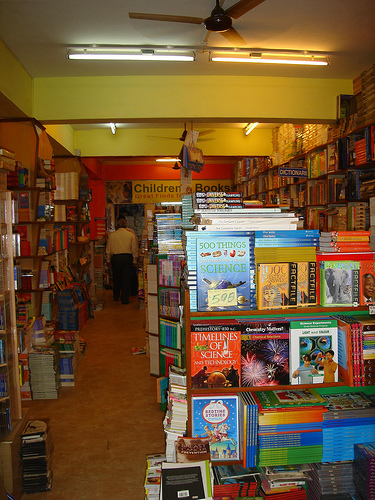
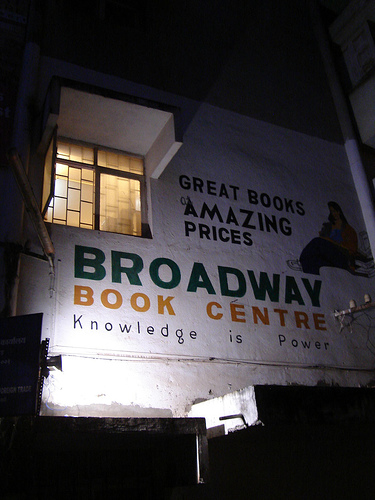
Broadway, at St Inez.
Besides this, there are others like the Coutinhos of Margao, whose sprawling premises in an old-styled Goan house is in the heart of the city. Located behind the Margao main post office, it is called Golden Heart Emporium. In one room, a number of Goa-related books lie crowded in shelves, vying for the reader’s attention.
Special ‘Goa sections’ for local bookshops are a fairly recent trend though.
Bookshops that first made their Goa book sections visible included the Other India Bookstore, a charming place almost hidden — but widely written about in travel guides and known in alternative Indian publishing circles — above the old Mapusa Clinic at Mapusa. OIBS is an alternative network that has a good selection and does a lot of mail-order business.
Lawyer Norma Alvares has been associated with this network as a trustee, and has displayed innovation and the ability to build a market where none existed. Besides their environmental, activist and NGO books, the OIBS also has a long-standing commitment to promoting Goa-related books.
OIBS, till recently, would activelytrack down and chase self-published authors. By pursuing those who came out with a book on Goa, they managed to put together a wide choice of Goa-related books, in a market that is otherwise fragmented, and marked by a lot of difficulties in finding the books you need.
* * *
This is a major problem with Goa books. Most are self-published, or brought out by small-time publishers.
Apart from the OIBS, Golden Heart at Margao, and Broadway, those with good Goa-related book sections include The Hotel Mandovi’s bookshop, and even the unusual Literati, just off the Calangute-Candolim road. It would probably help if there was more reader-pressure on bookshops to stock more Goa-related titles.

Margao’s Golden Heart Emporium.
There are other factors too.
Having good bookshops does help. It’s not just numbers sold that matters; even the glamour of the printed word grows, and could get taken more seriously.
Says the prestigious Frommers.com, one of the best travel guide in America: “It’s Literati … that has the atmosphere. You can sit for hours in the terrific book cafe and read or browse or buy secondhand as well as newly published works, while at the same time enjoying a delicious brownie or a tall glass of chilled kokum (fruit drink). Ask owner Divya Kapur about any upcoming events like poetry or book readings and writing workshops.”
Writer Shikha Tripathi writes online at myfidgetyfeet.com: “As uncanny as chalk and cheese, Goa and books sounds like a divorced idea. My last trip to the place, however, revealed the literary culture of a place I had previously equated not with books but with the greater known b’s — beer and beaches.”
* * *
Things are changing fast. The bookshops are there; so are the books, and the authors. So what stops Goa-related titles from getting a better place in the local sun — not to forget wider national and diaspora markets?
Like the proverbial chain, the strength here too is that of the weakest link! For most in the field, the distribution networks, or lack of them, is the serious most constrain that Goa currently faces in making its books viable and visible.
Talk to any author, publisher or reader, and the most common complaint is that books don’t travel beyond Goa. Not even to cities which have large Goan pockets, and could be potential markets.

Amitav Ghosh, one of the writers who has made Goa his home for part of the year.
But, to be fair, it takes for a huge cost and many challenges to even try to tap this scattered market. Pinto points to the disappointing experience of his book not reaching diaspora communities, even via mail-order networks. But book sellers here have to cope with difficult and costly (or unavailable) payment mechanisms, delays in receiving payments, and poor communications. Unless this severe bottleneck is somehow overcome, a lot of potential will remain stymied.
Cecil Pinto agrees that things are falling into place: “Writers and readers can be from anywhere. They don’t have to be physically present in Goa. Editing, illustration, photography, designing, printing, packaging and publicity talent and facilities exist here. What we need is an efficient distribution network which can make the book visible and available locally, all-India and worldwide.”
But others see the problem as lying elsewhere.
“Publishers in Delhi takes time to come out with a book but they take care of all aspects of publishing. In some cases, the publication needs to be financed by the author. The author has no control or idea of number of copies published,” she adds. Dr Gracias has published four books, two each in Delhi and Goa, and is awaiting completion of the fifth.
Add to this the other typical problems of a small and scattered market. Books can be published in limited numbers — usually a thousand copies, sometimes 500. This pushes up costs and makes it costlier to promote each book.
Money can be slow to return, both for authors and publishers.
* * *
Yet, despite this, publishing continues unabated. Goa comes out with a significant number of titles each year.
In the mid-1980s, after reading a really insightful essay by a Western scholar on Goa, this writer began collecting books on the region. Today, one has a collection of about 28 shelves of Goa books, each with approx 30 books, reports and the like. Others like ex-librarian and Goanvoice.Org.UK editor Eddie Fernandes has a collection of a few thousand books. All related to Goa.
Loretta Nunes, manager of the Other India Bookstore, volunteers to count the number of available books on the Mapusa-based outlet’s “Goa books catalogue”. It’s over 190 right now! Goans seem to be the most prolific — for reasons tough to understand — in the fields of biographies, history, religion, tourism and cookery (for obvious reasons).
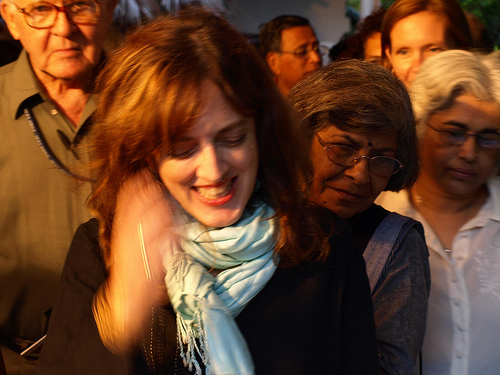
Margaret Mascarenhas (front), another prominent local writer.
“Some books don’t move (sell) fast. Most Goans don’t buy books. It’s the foreigners who go for it,” she says. But this may also be because the OIBS has received favourable mention in places like the trendy Lonely Planet guide, which, in turn, influences many foreign tourists to visit.
OIBS, and its sister organisation, the Other India Press, are quaint outfits, which trace their roots to the environmentalist couple, Dr Claude and Advocate Norma Alvares. Almost hidden by an un-typical entrance at the rear of the old Mapusa Clinic building, this outlet is unknown to most Goans. But it does, as mentioned, good mail-order business, and is known across the country and beyond. It has a wide selection of environmental and activist titles, and now, a rich selection of Goa books too.
* * *
The other part of the puzzle is the book collector, mentioned above. There are perhaps a handful of hard-core addicts who collect every Goa-related book they could get their hands on.

Konkani writer N Shivdas, currently head of the Goa Konkani Akademi.
Leroy Veloso is one such avid collector of Goa books, based in Moira. He began buying books on Mumbai’s street markets in 1998, when he first went to work on board the ship. He started collecting Goa books since 2006, when he changed careers and opted for the shore.
Veloso argues: “I don’t think there is much market for Goa books in Goa, people expect to get free copies of books. Also I feel the government should make it compulsory, or facilitate, the publication of PhD theses on Goa issues, as these are simply lying in the Goa University library now.”
Expat Bosco D’Mello, from Toronto and earlier from Bombay who traces his roots to the Bardez village of Socorro, says: “Books from Goa fill a void in my understanding of Goa and its people. It supplements my knowledge of Goa and Goans through the ages and helps understand how Goan society has morphed into its present state. I am drawn to non-fiction and historical manuscripts although I do own novels authored by Goans or about Goa. The other reason I buy books authored by Goans — fiction or non-fiction — is to support Goan writers.”
He suggests that copies of Goa-related books should be donated or submitted to public libraries in cities around the world that have large Goan populations. Goan associations could also act as channels to popularise Goan books. Interested Goans could act as local points of contacts for selling such books, he suggests.
Leading hotels in Goa could purchase large volumes of Goa-related books at cheaper prices and handout to their guests as part of a welcome package, he suggests. But, of course, it’s a question of everybody just taking care of their own business interest. So….
* * *
When one talks to different interest-groups involved, it becomes clear how disparate the concerns are.
Sheela Jaywant, a Goan author, compares the local market with Mumbai: “Not much difference between the two. Goa being smaller, everyone knows everyone and books have to be given free. Mumbai is bigger, one has lots of colleagues and acquaintances, and books have to be given free.”
She adds: “Price-wise, too, not much difference for a self-publisher. Ah yes, many in Goa have space to store the undistributed books. In Bombay, that’s one big pain!”
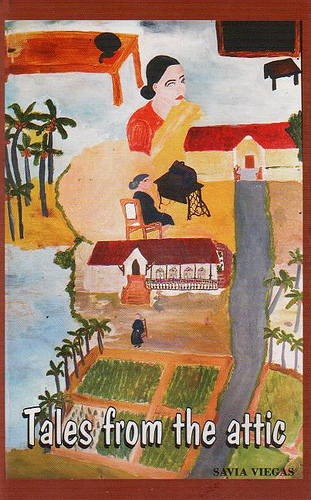
Tales from the Attic, by Savia Viegas
“I took self-publishing as a way to leverage my writing into public space,” says former journalist and academic Savia Viegas, who recently sold a thousand copies of her novel set in Goa, ‘Tales from the Attic’. To do so, she went beach-to-beach, around Salcete where she lives, acting as “hawker” to many, including to visiting tourists.
Cut to Rama Harmalkar (40), a traditional printer who studied the art in Bicholim. Harmalkar quickly realised that there is a need for quality print jobs, and outsources his work to printers in Mumbai. For a marginally higher price, he offers a quality job, which has drawn business for him from a wide section of those going in for book publishing, both individuals and some publishers.
Rangel-Ribeiro says: “Publishing in Goa differs from publishing as it is practiced in the West: in Goa, a publisher seems to be any individual who takes a manuscript and prints it. A book launch is held, people are invited, and the book is considered published.”
Even when backed by a knowledgeable and powerful array of forces — acquisition staff, editors, copy-editors, legal experts, proofreaders, a sales force, advertising and PR — books that are published in the West often fail to sell. “To me it seems that most books that are written and published in Goa are orphaned and abandoned at birth. It is a miracle that books published in Goa sell at all,” says Rangel-Ribeiro, not mincing his words.
Indo-Portuguese historian Dr Teotonio R de Souza, based in Lisbon and working towards a reprint of his ‘Medieval Goa’, believes that writers need to improve their inputs into their books. He calls for rigorous scholarship in the social sciences, relating contents to actuality (even in History), and the courage to face controversial issues like caste, conversions or colonialism. Souza was founder-director of the Xavier Centre of Historical Research, and some of their books have been published through networks like Concept, New Delhi.
* * *
Unfortunately, language is another factor that fractures the Goa market; not to decry diversity. For instance, outlets which stock English-language books might not keep Konkani and Marathi titles, or vice versa. Inspite of Goa’s multilingual situation, very few translations happen here still.
Visibility of Goa books is another issue. In a situation of profound ignorance about new books being published, how are potential buyers to get to know of what’s available? South Goa is getting a plush new district library opened, and one suggestion is to hold a permanent exhibition of books published in Goa. Likewise, Goa, with its pleasant weather for much of the year, could hold open air book-fairs to widen its market. Indoor fairs for books are held here, but these lack the scale or colour needed to draw in the crowds.
Goa’s postal service needs to offer better facilities, if wider markets are to be tapped. At Panjim’s General Post Office, one could run into widely fluctuating postal rates and unawareness, though the official policy is actually quite helpful and aimed at offering books preferential postal rates.
Much needs to be done to promote the reading habit in Goa too. Despite claims, the village libraries set up in Goa in the 1980s are either in a state of collapse, or not growing significantly. Showing an inability to run the network of village libraries, the government is now handing these over to voluntary groups. This may work in some cases, but the need for an expansion of village libraries is undeniable.
* * *
Prabhakar Bhide, of the Rajhauns Vitrans, heads an active publishing house started in 1981. Till date, they have a total of 941 titles in print, including school and educational books, Bhide says.
While Goa books have a small market, the reading habit is actually improving, he feels. Among his popular books, he lists Goa, A Social History (by P D Xavier), Magnificent Monuments (by Xavier Lobo), the recently reprinted The Goa Inquisition (A K Priolkar) and Goan Home Wines (by Edwin Saldanha).
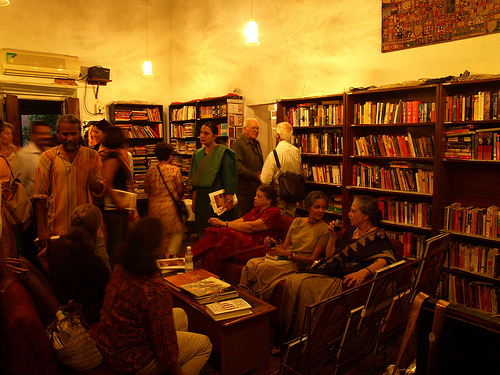
Literati, a fashionable bookshop where Calangute meets Candolim.
Broadway’s managing director Khalil Ahmed says his bookshop is keen on publishing titles from the region. “It takes time to recover the investment, but it’s okay. Though this is a small market, there is still scope. One cannot predict which book will click,” says he.
He praises government support, and says this helps too. Broadway has published some 15 titles. Faheem Ahmed (24), the next generation at the firm, says publishing Goa is their way of giving back to a state which hosts their business.
Author Vishnu Wage (44) has himself authored and published 15 titles (six collections of poetry, four plays, one biography, two in free verse, and two satires). Besides this, he’s also been an editor, a theatre personality, a cartoonist, and a politician!
What’s the economics of publishing these books?
Says he: “I’ve self-published my books. But I also have a tie-up with distributors in Maharashtra, and give it to them to sell. This (selling in Maharashtra) is not possible if one writes in Konkani. It’s very tough to move from door to door selling books (laughs).” To ensure attractiveness, Wagh says he’s careful to maintain layout and production standards, while making the books aesthetically appealing too.
Says Dr Pratap Naik, a Jesuit scholar and Konkani promoter: “Whether we published our own or published by others, experience is not so good. Sales are limited.”
“‘Romans’ (Romi Konkani fiction) used to sell because readers then didn’t know English. Konkani was the only option (in those times). Who reads Konkani now? Those who were earlier Konkani readers have now learnt English,” he says.
In his view, the religious publication ‘Dor Moneachi Roti’ (at one stage even published from Karachi) and the ‘Romans’ were two ways for keeping the Goan Catholic in touch with their culture and Konkani in the past. “If (Konkani pulp fiction is) reprinted today will it sell? I have my doubts. That readership is all but gone,” he says, sounding pessimistic. TV, DVDs and audio cassettes offer stiff competition to books too.
“Devanagari books thrive because of government support. It’s not a question of whether a hundred or a thousand books are published each year. My challenge is, the the government stop giving grants, and spend that money on welfare of the people… that will give us an indication of whether people really need Konkani,” says Naik.
This could be seen as a reflection of the Devanagari-versus-Romi script battle that has been going on in the Konkani world here. But, Naik agrees that the pressure of a reader-shortage is being felt in the Romi world too.
Yet, despite all the many problems, there are signs of change. Books are reaching the presses in growing numbers. One cannot overlook the role of books in generating ideas and knowledge. To ignore the low-returns field of book publishing in a small market would be a crucial error, and as things are moving — with many advantages in its favour — Goa has no alibi for not taking this sector seriously.
—-
Frederick Noronha, a journalist for 25 years, recently himself ventured into a small, alternative publishing venture Goa,1556 [http://goa1556.goa-india.org]
*********************************************************
BOX: The rat and the lion
*********************************************************
It takes an American anthropologist to underline the point
that publishing a Goa book in Goa itself makes good sense.
Dr Robert S Newman, the Marblehead (Ma.) based
anthropologist, says, “My experience in publishing
my Goa related book was basically good. I published
my book in Goa because I left academia and didn’t
need to impress anyone with my ‘hotshot skills’ and
‘great intellect’. More simply put, I wasn’t
gunning for a promotion.”

Above, Dr Robert ‘Bob’ S Newman. Photo FN
Newman, earlier at La Trobe University in Australia, says he
“just wanted people to read what I wrote.” The most important
people for him, he says, were Goans, since his work is on
this place.
Publishing a Goa book some distant, bigger centre would only
push up costs. “Also, interest in Goa in the wide world is
rather limited. Many publishers in the West would
automatically say, ‘This book is not going to sell.’ In Goa,
that would not be the case,” he notes.
In the late 1990s, when Newman published here, then as now,
there was a limited choice by way of publishers he could
approach.
Yet, he says: “I think the challenge does not lie in the lack
or plenitude of publishers. It is in the quantity or quality
of manuscripts available. Things have to be written in order
to get published.”
Newman, from distant North America, reminds us of the crucial
task of knowledge creation.
“If we look at Anthropology, where are the manuscripts? Who
is encouraging (Dr Bernadette) Gomes to write the various
things she could write? Why did she receive so little
encouragement over the years? Coffee table books probably
sell more, but they do not constitute “better books” in my
opinion. Who is pestering Alexander Henn, Alito Siqueira,
Manuel Magalhães, Jason Fernandes, Claudia Pereira, and a
few others to hurry up and produce a manuscript? Nobody.
What about the writers of literature?”
Looking back, Newman says: “When I came to Goa in
2006, there was a lot of interest in the book and
people had heard about my work. That was
fantastic. They heard of me in “Goa” circles in
Portugal too.”
If he had written the “same kind of stuff” on Afghanistan or
Iraq, it might have brought better returns, Newman suggests.
He argues: “Books on India at large might sell more or be
more widely read. But I always felt glad that I studied Goa
and wrote on Goa because I opened the door — there really
wasn’t much anthropology on Goa before.”
“It was kind of a pioneering work and I’ve always hoped that
a bunch more would follow, building up on what I started. I
wanted my book to be available in Goa and that’s what
happened. As they say in South America — mejor la cabeza de
raton que el culo de leon! (Better the head of a rat than
the arse of a lion!)”
*********************************************************
PUBLISHED, IN A SLIGHTLY ADAPTED VERSION, FIRST IN Goa Today, August 2009.












































